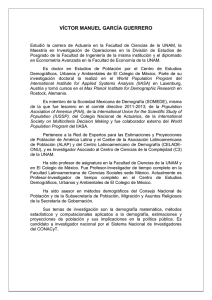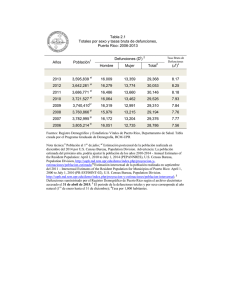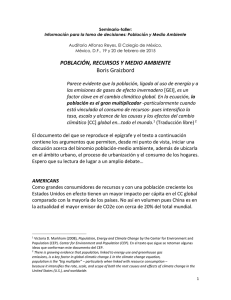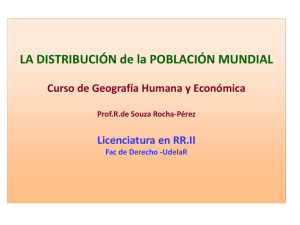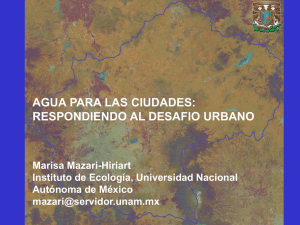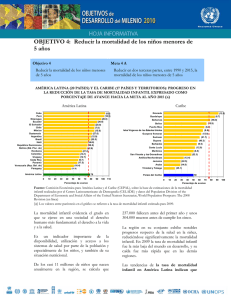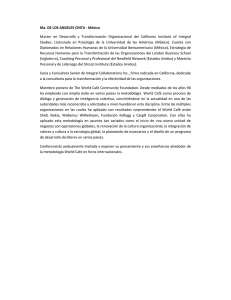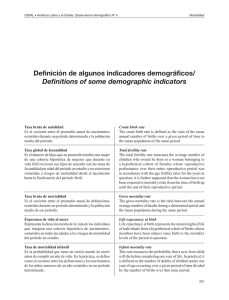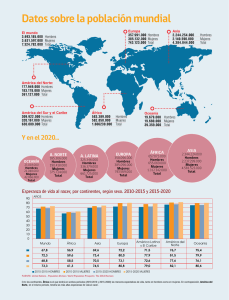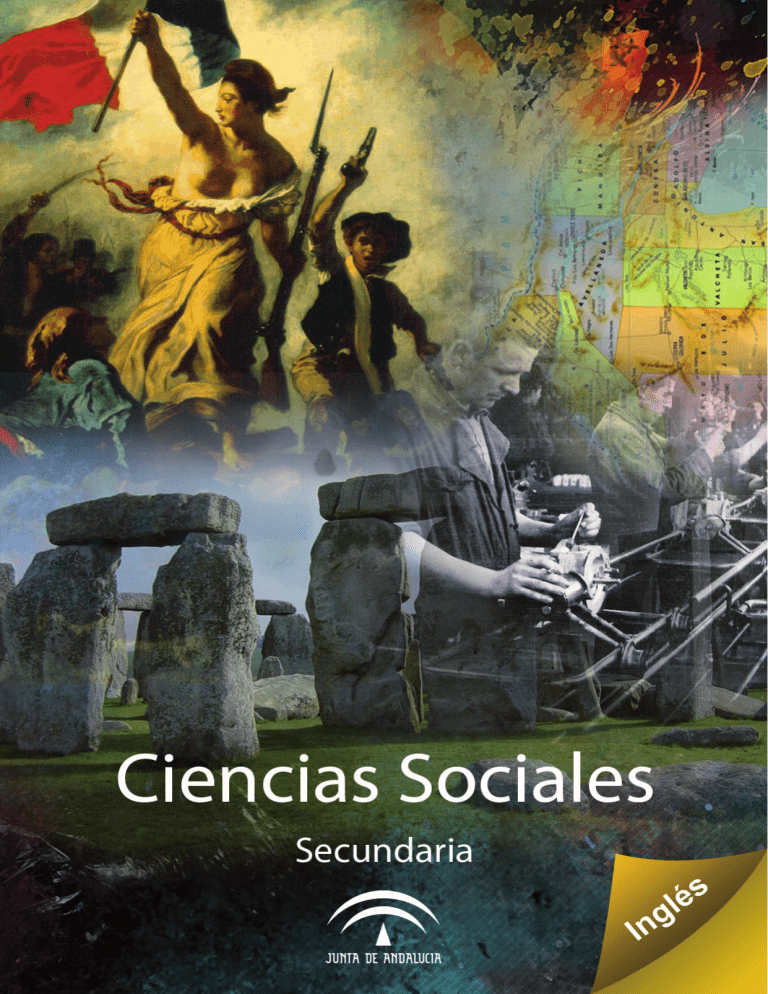
CONSEJERÍA DE EDUCACIÓN
Dirección General de Participación e Innovación Educativa
Identificación del material AICLE
TÍTULO
World Population
NIVEL LINGÜÍSTICO
SEGÚN MCER
A2.1
IDIOMA
Inglés
ÁREA / MATERIA
Ciencias Sociales (Geografía e Historia)
NÚCLEO TEMÁTICO
Geografía de la población
GUIÓN TEMÁTICO
El tema no pretende ser un análisis exhaustivo de la Geografía de la población.
Se centra en determinados aspectos como: la evolución de la población a lo
largo de la Historia, distribución de la población en España y en el mundo y
causas de dicha distribución, las tasas demográficas, la teoría de la transición
demográfica, y un estudio detallado de la demografía mundial por países.
FORMATO
Material didáctico en formato PDF
CORRESPONDENCIA
CURRICULAR
2º de Educación Secundaria
AUTORÍA
Antonio Rus Martínez
TEMPORALIZACIÓN
APROXIMADA
Sesión 1. Human population through History
Sesión 2. The distribution of the population: population density
Sesiones 3 y 4. Population rates
Sesión 5. The Demographic transition model
Sesiones 6, 7 y 8. Project
Sesión 9. Final activities
Sesión 10. What I have learned
COMPETENCIAS
BÁSICAS
Competencias específicas del área:
Competencia en el conocimiento y la interacción con el mundo físico (comprensión de la realidad demográfica mundial), Competencia social y ciudadana (toma
de conciencia de la desigualdad demográfica mundial), Competencia cultural y
artística (análisis de fotografías artísticas).
Competencias generales:
Competencia en comunicación lingüística, Competencia matemática, Tratamiento de la información y competencia digital, Competencia para aprender a aprender, Autonomía e iniciativa personal
OBSERVACIONES
- La unidad está pensada para trabajarla en su conjunto, pero también con la
opción de hacer cada parte de forma independiente
- Algunas de las actividades finales están pensadas para atender a la diversidad
(ej. Reading, Let’s investigate)
Material AICLE. 2º de ESO: World
Population
3
Tabla de programación AICLE
OBJETIVOS
- Desarrollar y consolidar hábitos de disciplina, estudio y trabajo individual y en equipo
como condición necesaria para una realización eficaz de las tareas del aprendizaje y
como medio de desarrollo personal
- Valorar y respetar la diferencia de sexos y la igualdad de derechos y oportunidades
entre ellos. Rechazar los estereotipos que supongan discriminación
- Desarrollar destrezas básicas en la utilización de las fuentes de información para,
con sentido crítico, adquirir nuevos conocimientos. Adquirir una preparación básica en
el campo de las tecnologías, especialmente las de la información y la comunicación.
CONTENIDOS DE
CURSO / CICLO
Bloque 2. Población y sociedad.
La población. Distribución. Aplicación de los conceptos básicos de demografía
a la comprensión de los comportamientos demográficos actuales, análisis
y valoración de sus consecuencias en el mundo y en España. Lectura e
interpretación de datos y gráficos demográficos.
Las sociedades actuales. Estructura y diversidad. Desigualdades y conflictos.
Caracterización de la sociedad europea y española. Inmigración e integración.
Análisis y valoración relativa de las diferencias culturales.
TEMA
1. Human population through History
2. The distribution of the population: population density
3. Population rates
4. The Demographic transition model
MODELOS
DISCURSIVOS
- Definir conceptos
- Describir mapas y fotografías
- Dar opiniones razonadas
-Resumir textos
- Tomar notas tras un listening o una explicación
- Clasificar conceptos
- Explicar las causas de la variabilidad de las diferentes tasas demográficas según el
grado de desarrollo de los países
- Buscar la información demográfica de un país
- Exponer oralmente la información obtenida tras una búsqueda
TAREAS
CONTENIDOS
LINGÜÍSTICOS
CRITERIOS DE
EVALUACIÓN
4
- Resumen de las ideas principales de un texto sobre la evolución de la población
- Gráfica a rellenar sobre dicho texto
- Fórmulas sobre tasas demográficas para calcular
- Mapas sobre tasas demográficas para describir oralmente
- Toma de apuntes mientras el profesor explica
FUNCIONES:
-Diálogo en equipo
para la realización
de actividades
- Comentario y
comparación de
imágenes
- Estructuración de
un relato
ESTRUCTURAS:
- Para el diálogo
(Did you find __________?,
Look, __________’s here.)
- Para el comentario y la
comparación (The differences
are that in the first one…;in the
second one…).
Para la estructuración de un
relato (It follows, therefore, that)
LÉXICO:
Throughout, to increase,
growth, birth, death,
population, fertility, literacy,
female, male, to invest, to fall,
imbalance, balance…
Expressions
Developed countries,
constrictive pyramid,
expansive pyramid…
1. Describir los factores que condicionan los comportamientos demográficos
conociendo y utilizando los conceptos básicos de la demografía para su análisis
2. Identificar los rasgos característicos de la sociedad española actual distinguiendo la
variedad de grupos sociales que la configuran, el aumento de la diversidad
que genera la inmigración, reconociendo su pertenencia al mundo occidental y
exponiendo alguna situación que refleje desigualdad social.
Material AICLE. 2º de ESO: World
Population
Observe and think!
1. How many people are in the world? How about in Spain?
2. Do you think the population in the world is decreasing or increasing? Why?
3. Which are the densely populated areas in the world? How about the sparsely
populated areas? Why?
In this unit we are going to learn the fundamental aspects of the world's
and Spain's population. The work will be divided into two parts: first, we
will study the essential aspects of the demographic theory. Second, we
will carry out this theory through searching for the demographic
information of distinct countries of the world. With all the gathered
information we will draw our own conclusions.
CONTENTS
1. Human population through History.
2. The distribution of the population: population density.
3. Population rates.
4. The Demographic transition model.
5. Project.
6. Final activities.
7. What I have learned.
8. Links, bibliographies and acknowledgements.
9. Teacher version worksheet.
World population. Antonio Rus Martínez
Material AICLE. 2º de ESO: World Population
5
YESTERDAY
TODAY
TOMORROW (?)
= Developed countries.
6
Material AICLE. 2º de ESO: World
= Developing countries.
Population
World population.
Antonio Rus Martínez
= Resources.
1. Human population through History
Throughout most of human history, the number of people on Earth was
very little (just hundreds of thousands or a few millions), and the
population increased very slowly. Two thousand years ago, there were
around 250 million people in the world, and by the end of the 18th
century one billion.
At around that time, the population started growing much faster. From
one billion in 1800, it rose 6 billion in 1999. This is described as a
demographic explosion.
We should reach 7 billion by around 2011 or 2012, and growth will not
stop there. So what will happen next? The United Nations thinks that the
world population will reach 9 billion by around 2050.
Adapted from: http://www.ined.fr/en/everything_about_population/animations/world_population/
Vocabulary
Throughout: In.
To increase: To become larger.
To grow: To increase in size by a natural process.
Growth: The process of growing.
Rose: The past of to rise (To move from a lower to a higher position; to ascend).
To reach: To arrive at.
SUMMARISING
A summary is a shortened version of a text. It contains the main points in
the text and is written in your own words. A good summary shows that
you have understood the text. The following stages may be useful:
1.
2.
3.
4.
Listen to and understand the text carefully.
Select (highlight) the relevant information (the main ideas).
Delete most details and examples, unimportant information…
Find alternative words/synonyms for these complicated
words/phrases, but do not change specialised vocabulary.
5. Change the structure of the text. For example, change nouns to
verbs, adjectives to adverbs, etc. Reduce complex sentences to
simple sentences.
6. Check your work. Make sure your purpose is clear, the meaning is
the same, and the style is your own.
Material AICLE. 2º de ESO: World
Population
World population. Antonio Rus Martínez
7
1. Read the text and summarise it in your own words.
2. Complete the chart with the information given above.
3. Looking back in history,
- Why do you think the population grew so slowly up to the eighteenth century?
- Why do you think it started rising so fast from then on?
I think that…
…the population grew so…
…slowly/quickly…
…up to /from…
…the eighteenth century…
…because…
a. Of technical improvements in
agriculture and industry.
b. Of advances in medicine.
c. A lot of people died from hunger
and epidemics.
d. High birth and death rates.
e. High birth and low death rates.
F. …
4. Define demographic explosion.
8
Material AICLE. 2º de ESO:
World
Population
World
population.
Antonio
Rus Martínez
2. The distribution of population: population density
To measure population, we do not look at absolute population (the
number of people living in an area), but at population density.
Population density is the relation between the number of inhabitants and
the area they occupy.
Population density is calculated by dividing the number of people by the
area (in km²). It is usually shown as the number of people per square
kilometre.
1. Define:
- Absolute population:
- Population density:
2. Complete the formula:
Population density = _______________________
3. If the world's population is 6.8 billion, and Earth's total area (including
land and water) is 510 million square kilometers (197 million square miles),
calculate the worldwide human population density.
Material
AICLE.
2º de ESO:Antonio
World Population
World
population.
Rus Martínez
9
The Earth’s population is not distributed evenly: some areas have a high
population density (Densely populated areas) while others have a low
population density (Sparsely populated areas), as you can see in the
following map:
Countries of the world by population density (30 March 2006 ). Figures in people per km².
1. Work with a partner to:
1. Look at the map and complete the chart (WHERE) with the parts
of the continents (N, S, E, W) or the names of some countries.
Sparsely populated areas
Densely populated areas
WHERE
WHERE
- 0-9 people per km²:
- 100-999 people per km²:
-10-49 people per km²:
-1000 + people per km²:
REASONS
10
Material AICLE. 2º de ESO:
World
Population
World
population.
Antonio
REASONS
Rus Martínez
2. Organize the following words or sentences into the categories in
the boxes (previous page). Ask your partner what he or she thinks,
for example:
Where does
desert go?
What do you
have for
rainforest?
No, I don’t think
rainforest goes
with politics.
REASONS
3. Finally, compare with a different group.
4. Describe and compare the following pictures.
The first picture represents…;the second…
The differences are that in the first one…;in the second one…
While in the first picture there are…in the second…
Material AICLE. 2º de ESO: World
Population
World population. Antonio Rus Martínez
11
3. Population rates
A rate is a measure of a part with respect to a whole; a proportion. To
study the population we need some rates. The most important are:
BIRTH RATE, FERTILITY RATE, MORTALITY RATE, INFANT MORTALITY,
LIFE EXPECTANCY, AGE STRUCTURE, POPULATION GROWTH RATE and SEX
RATIO.
VOCABULARY
1. Try to define with your own words the vocabulary.
- Birth:
- Death:
- Population:
- Fertility:
- Literacy:
- Female:
- Male:
- Growth:
- Developed countries:
- To invest:
12
Material AICLE. 2º de ESO: World
Population
BIRTH RATE (BR)
The birth rate in a place is the number of babies born there for every
1000 people during a particular period of time.
Countries by birth rate in 2008 (from CIA World Factbook)
CIA: The Central Intelligence Agency of the United States.
1. Describe the map.
The map shows …
_______________ has the highest birth rate, around ______________
_________________ has the lowest birth rate, around _____________
The birth rate is medium in _______________, around _____________
Material AICLE. 2º de ESO: World
Population
13
2. Which factors do you think affect birth rate? Work with a partner to
categorize the following reasons in the right box. Then, try to explain how
these factors influence. Some things to remember…
Where does ________ go?
I think ____________ is a ___________.
Where did you put _________? I can’t remember where _____________ goes.
Does this go here?
_________ goes in ___________
What does this word mean? No, ___________ doesn’t go in _____________.
What did you put?
We put that ___________ goes in _____________.
Factors affecting birth rate
- Poverty levels.
- Economic prosperity .
- Social and religious beliefs : especially in relation to contraception and abortion.
- Female literacy levels.
- Typical age of marriage.
Developed countries
Factor:
Economic prosperity
Reason
Underdeveloped countries
Factor:
Poverty levels
Reason
Although
in
theory
when
the Children can be seen as an
economy is doing well families can economic resource in developing
afford to have more children, in countries as they can earn money.
practice the higher the economic
prosperity the lower the birth rate.
14
Factor
Factor
Reason
Reason
Factor:
Factor
Reason
Reason
Factor:
Factor
Reason
Reason
Material AICLE. 2º de ESO: World
Population
FERTILITY RATE (FR)
The fertility rate in a place is the number of babies born there for every
1000 women (between the ages of 15 and 49 years old) during a
particular period of time.
“Bri, Joel & Indy” (a one-child family). At right, “sisters and brothers”.
1. Describe and compare the two pictures and give your opinion.
The picture on the left/right represents…
I think the picture … has been taken in…
In my opinion, the fertility rate in
developing/underdeveloped countries is…
because …
Christian evangelical's 18th baby creates the 'world's largest family'
Michelle Duggar, a 42-year-old Arkansas woman, has given birth to her
18th child. She and her husband, who claim to be the world's biggest
family, has used almost 100,000 nappies and nearly seven liters of milk a
day. The Duggars have their own official website (http://www.duggarfamily.com/).
Material AICLE. 2º de ESO: World
Population
15
Adapted from: http://www.guardian.co.uk/world/blog/2008/dec/19/duggars-babies
MORTALITY RATE (MR)
The mortality rate in a place is the number of people that died (death)
there during a particular period of time.
Countries by death rate in 2006 (from CIA World Factbook).
1. Describe the map.
2. Which factors do you think affect death rate? Work with a partner to
categorize the following reasons in the right box.
Factors affecting death rate
HIV-AIDS, ischaemic heart disease, cerebrovascular disease, cancer, car
accidents, suicide, diarrhoeal diseases, malaria, tuberculosis, childhood
diseases, lower respiratory infections…
Developed countries
16
Material AICLE. 2º de ESO: World
Population
Underdeveloped countries
INFANT MORTALITY (IM)
The infant mortality rate in a place is the number of children under the
age of one that die there during a particular period of time.
Currently the most common cause is pneumonia. Other causes of infant
mortality include malnutrition, malaria, congenital malformation, infection and
SIDS. Infanticide (gendercide), child abuse and child abandonment may also
contribute to infant mortality.
World infant mortality rates in 2008
1. Describe the map.
2. Why do you think Infant mortality affects more developing countries
that developed countries?
3. ¿What is gendercide? Write your opinion about the following sentence.
"As to children, a father and mother when they produce a boy congratulate
one another, but when they produce a girl they put it to death."
Philosopher Han Fei Tzu, a member of the ruling aristocracy (China, 3rd century BC)
3. What does the following cartoon have to do with infant mortality?
Material AICLE. 2º de ESO: World
Population
17
LIFE EXPECTANCY (LE)
The life expectancy at birth in a place refers to the number of years
someone is expected to live there.
Life expectancy world map (IA World Factbook 2005)
1. Describe the map.
AGE STRUCTURE (AS)
Age structure provides the distribution of the population according to
age. Information is included by sex and age group (0-14 years, 15-64
years, 65 years and over). The age structure of a population affects a
nation's key socioeconomic issues. Countries with young populations
(high percentage under age 15) need to invest more in schools, while
countries with older populations (high percentage ages 65 and over)
need to invest more in the health sector.
1. How is the Age structure in the following population pyramids? Which one will
have to invest more in schools and which one in the health sector?
18
Material AICLE. 2º de ESO: World
Population
POPULATION GROWTH RATE (PGR)
The population growth rate in a place is the difference between the
numbers of births and deaths there during a particular period of time.
The overall growth rate takes migration into account (immigration minus
emigration).
Population growth rate world, including the variables of births, deaths, immigration, and emigration (2006)
1. Describe the map.
2. Overpopulation is when there are excessive population in an area and
little resources. Look at the following map and write the name of the
areas that are going to be overpopulated by 2050.
Material AICLE. 2º de ESO: World
Population
19
SEX RATIO (SR)
The sex ratio is the number of males for each female in a population. The
CIA estimates that the current world wide sex ratio at birth is 107 boys to
100 girls.
Sex ratio of total population per country (2006 CIA World). Scale from blue to red: Blue
(bellow 0.81 males/female), White (1.01 males/female), Red (above 1.21 males/female).
1. Describe the map.
2. Which countries have the highest sex ratio? What do you think is the
reason? Do you think that sex segregation has something to do with it?
Did you know?
Saudi women sometimes face discrimination in
many aspects of their lives, such as the justice
system. It is believed that a woman's place is in
the home caring for her husband and family. The
treatment of women has been referred to as "Sex
segregation" and "gender apartheid”. Here are
some examples:
-
A young Saudi woman wearing a
traditional hijab.
20
Material AICLE. 2º de ESO: World
Although they make up 70% of those
enrolled in universities, for social reasons,
women make up just 5% of the workforce
in Saudi Arabia, the lowest proportion in
the world.
Women are legally not allowed to drive
cars.
According to the CIA world factbook,
70.8%
of
females
are
literate,
in
comparison to 84.7% literacy rates in males.
Population
4. The Demographic transition model
Introducing vocabulary
Listening comprehension
NOTE-TAKING versus NOTE-MAKING
Note taking is when you are reading or hearing something for the first
time and you are trying to get the information so that you can use it later.
Note-making is when you return to these notes and make more notes on
them. This means you annotate them, put things into your own words or
summarise them and highlight key points.
Material AICLE. 2º de ESO: World
Population
21
1. NOTE TAKING ACTIVITY. Listen to your teacher/assistant. Fill in the gaps
on the following text.
The Demographic transition model is a model used to represent the
transition from high birth and death _____ to low birth and death _____ as
a country develops from a pre-industrial to an industrialized economic
system.
The transition involves ____ stages, or possibly ____.
1. In stage one, that of a preindustrial society, _____ rates and
_____ rates are high and roughly
in _______. The population ______
rate is very low, or negative. The
population pyramid is _________:
life __________ is ___, and most of
the population is under __ years
old.
2. In stage two, that of a
developing country, the _____
rates _____ rapidly. The _____
rates continue being high, and
this produces an _________, so
the population ______ rate is very
high.
3. In stage three, _____ rates ____.
The _____ rates continue falling.
Population ______ is low.
4. During stage four, that of a
industrialized economic system,
there are both low _____ rates
and low _____ rates and roughly in
_______. The population ______
rate is very low, or negative. The
population
pyramid
is
____________: life expectancy is
high (many of the people are
aged __ or over) but there are
few ________.
22
Material AICLE. 2º de ESO: World
Population
2. NOTE TAKING ACTIVITY. Listen to your teacher/assistant while he/she
explains The Demographic transition model and take notes. The following
diagram will help you to understand.
A diagram of the demographic transition model, including stage 5
STAGE 1
The death rate is
The birth rate is
The population growth rate is
STAGE 2
The death rate falls because
The birth rate is
The population growth rate is
STAGE 3
The birth rate falls because
The death rate is
The population growth rate is
STAGE 4
The death rate is
The birth rate is
The population growth rate is
STAGE 5
The death rate is
The birth rate is
The population growth rate is
Material AICLE. 2º de ESO: World
Population
23
3. NOTE MAKING ACTIVITY. Now, with all the notes, put things into your
own words or summarise them and highlight key point. Don’t forget to
explain the reasons (because) and to structure the sentences well (It is
a…, It follows, therefore, that…). For example:
The Demographic transition model is a model that represents the
transition from high birth and death rates (typical of pre-industrial
countries) to low birth and death rates (typical of industrialized countries).
It has five stages:
In stage one, the death rate is high and the birth rate is high. The death
rate is high because of deseases and malnutrition. The birth rate is high
because children can be seen as an economic resource in pre-industrial
societies. It follows, therefore, that the population growth is low or
negative. Life expectancy is low and most of the population is under 15
years old (wide base of the pyramid population). The pyramid
population is expansive.
In stage two
In stage three
In stage four
In stage five
24
Material AICLE. 2º de ESO: World
Population
5. Project
The class is going to divide into groups to look for the information about
the population of some countries. Students will have to make a poster
with all the information and, after that, they will present their poster to
the class. Useful website includes:
http://www.indexmundi.com/
COUNTRIES
Material AICLE. 2º de ESO: World
Population
25
SPAIN (developed)
-Location:
Southwestern Europe, bordering the Bay of Biscay, Mediterranean Sea, North
Atlantic Ocean, and Pyrenees Mountains.
- (Absolute) population:
46,188,000 people (2009).
- Area:
505,370 sq km.
- Population density:
46,188,000/505,370 sq km.: 91.39 people per square kilometre
The population density is high because of the temperate climate, the mineral
resources, accessibility, the availability of water, fertile land and good
economy.
The densely populated areas are in the coast.
The sparsely populated areas are in the interior (except from Madrid).
- Age structure
0-14 years: 14.5% (male 3,021,822/female 2,842,597)
15-64 years: 67.4% (male 13,705,107/female 13,601,399)
65 years and over: 18.1% (male 3,071,394/female 4,282,683)
- Median age
41.1 years (male: 39.7 years; female: 42.5 years)
- Birth rate
9.72 births/1,000 population (2009 est.)
- Mortality (or Death) rate
9.99 deaths/1,000 population (July 2009 est.)
- Population growth rate
0.072% (2009 est.)
- Sex ratio
0.96 male(s)/female (2009 est.)
- Infant mortality
4.21 deaths/1,000 live births
- Life expectancy
80.05 years
- Fertility rate
1.31 children born/woman (2009 est.)
- Literacy:
97.9% (male: 98.7%, female: 97.2%)
- Stage of the Demographic transition model
Four stage, that of an industrialized economic system, there are both low birth
rates and low death rates and roughly in balance. The population growth rate
is very low, or negative. The population pyramid is constrictive: life expectancy
is high (many of the people are aged 65 or over) but there are few children.
26
Material AICLE. 2º de ESO: World
Population
NAME OF THE COUNTRY
(developed/developing/ underdeveloped)
-Location
- (Absolute) population
- Area
- Population density
- Age structure
- Median age
- Birth rate
- Mortality (or Death) rate
- Population growth rate
- Sex ratio
- Infant mortality
- Life expectancy
- Fertility rate
- Literacy (male and female)
- Stage of the Demographic transition model:
Material AICLE. 2º de ESO: World
Population
27
6. Final activities
1. Do the crossword.
28
Material AICLE. 2º de ESO: World
Population
2. Unscramble the names seen in the previous activity (?).
3. Define the following words:
- Demographic explosion:
- Population density:
- Birth rate:
- Fertility rate:
- Mortality rate:
- Infant mortality:
- Life expectancy:
- Age structure:
- Population growth rate:
- Sex ratio:
4. Which are the densely populated areas in Spain? How about the
sparsely populated areas? Why?
Material AICLE. 2º de ESO: World
Population
29
5. Calculate the population density for each country.
COUNTRY
Mongolia
China
Belarus
United States
Population
3,041,142 (2009)
Area in km²
1,564,116
1,338,612,968 (2009) 9,596,961
9,648,533 (2009) 207,600
307,212,123 (2009) 9,826,675
Population density
6. Look at the chart.
a. What does the chart compare? Which countries are being
compared?
b. Describe the situation in the different countries.
United States
Mali
Germany
Afghanistan
Cambodia
c. Write your conclusions.
30
Material AICLE. 2º de ESO: World
Population
7. Let’s investigate!!
Why Zimbabwe has the world’s lowest life expectancy? Useful website
include:
http://www.independent.co.uk/news/world/africa/dead-by-34-how-aids-and-starvation-condemnzimbabwes-women-to-early-grave-424669.html
http://news.bbc.co.uk/2/hi/africa/4890508.stm
8. THINKING! The following picture is called “His little world...” Describe it.
Do you like it or not? What does the author (called Fearless) try to say
with this artwork?
Material AICLE. 2º de ESO: World
Population
31
READING
One of the world's oldest persons
Jeanne Louise Calment lived 122 years and 164 days (44,724 days total). She
lived in Arles, France, for her entire life. At age 12 or 13, she met Vincent van
Gogh, who had come to her uncle's shop to buy paint. Calment would
remember him as "dirty, badly dressed, and disagreeable" and "very ugly,
ungracious, impolite, sick". She entered the Guinness Book of Records in 1988,
and on 17 October 1995 was declared the oldest person who had ever lived.
Calment celebrating her 121st birthday in 1996. On the right, Calment at age 20 in 1895.
Calment's remarkable health presaged her later record. At age 84, she was still
doing fencing, and at 100, she was still riding a bicycle. Calment lived on her
own until shortly before her 110th birthday, when it was decided that she
needed to be moved to a nursing home after a cooking accident. However,
Calment was still in good shape, and was able to walk until she fractured her
femur during a fall at age 114 years and 11 months, which required surgery.
After her operation, Calment needed to use a wheelchair. She smoked until the
age of 117, only five years before her death. Calment smoked from the age of
21 (1896), but it seems that Calment smoked no more than two cigarettes per
day. She ascribed her longevity to olive oil, as well as a diet of port wine, and
ate nearly one kilo of chocolate every week.
http://en.wikipedia.org/wiki/Jeanne_Calment
Questions
1. Why is Calment famous?
2. How old was she when she died?
3. How did Calment meet Vincent van Gogh?
4. What do you think is the secret of longevity? Do you agree with
Calment’s point of view?
32
Material AICLE. 2º de ESO: World
Population
THINK!
Activity: What do the following quotes try to say?
- “...democracy cannot survive overpopulation. Human dignity cannot
survive it. Convenience and decency cannot survive it. As you put more
and more people into the world, the value of life not only declines, it
disappears”.
- "Which is the greater danger, nuclear warfare or the population
explosion? The latter absolutely! To bring about nuclear war, someone
has to DO something; someone has to press a button. To bring about
destruction by overcrowding, mass starvation, anarchy, the destruction
of our most cherished values-there is no need to do anything.
Isaac Asimov
1.___________________________________________________________________________________
_____________________________________________________________________________________
2. __________________________________________________________________________________
_____________________________________________________________________________________
“A finite world can support only a finite population;
therefore, population growth must eventually equal zero”.
Garrett Hardin
______________________________________________________________________
______________________________________________________________________
“Instead of controlling the environment for the benefit of the population,
maybe we should control the population to ensure the survival of our
environment”.
Sir David Attenborough
______________________________________________________________________
______________________________________________________________________
“We must alert and organise the world's people to pressure world leaders
to take specific steps to solve the two root causes of our environmental
crises: exploding population growth and wasteful consumption of
irreplaceable resources”
Jacques-Yves Cousteau
.________________________________________________________________
_________________________________________________________________
Material AICLE. 2º de ESO: World
Population
33
7. What I have learned
Human population through History
Two thousand years ago, there were around ____ million people in the
world. There were _____ billion in 1800 and there are almost ___ billion
today. This is described as a demographic ___________.
The distribution of the population: population density
Population density is the relation between the number of ______________
and the _______ they occupy.
The Earth’s population is not distributed evenly. There are:
1. ____________ ______________ _______, that have a high population
density. For example__________________________________________________
Some reasons are_____________________________________________________
2. ______________ ______________ _______, that have a low population
density. For example __________________________________________________
Some reasons are_____________________________________________________
- ___________________ is when there are excessive population in an area
and little resources.
Population rates
A rate is a measure of a _____ with respect to a ________. Population rates
varies depending on the country (complete with the conclusions of the
project):
In developed countries
The birth rate is
because
The fertility rate is
because
The mortality rate is
because
Infant mortality is
because
Life expectancy is
because
The age structure is
because
The population growth rate is
because
The sex ratio is
because
In developing countries
The birth rate is
because
The fertility rate is
34
Material AICLE. 2º de ESO: World
Population
because
The mortality rate is
because
Infant mortality is
because
Life expectancy is
because
The age structure is
because
The population growth rate is
because
The sex ratio is
because
In underdeveloped countries
The birth rate is
because
The fertility rate is
because
The mortality rate is
because
Infant mortality is
because
Life expectancy is
because
The age structure is
because
The population growth rate is
because
The sex ratio is
because
The Demographic transition model
The Demographic transition model is a model used to represent the
transition from _____ birth and death rates to ____ birth and death rates
as a country develops from a _____________ to an ______________
economic system. The transition involves _______ or ______ stages.
The things that caught my attention the most in the unit were:
And don’t forget to study the vocabulary!!!!
Material AICLE. 2º de ESO: World
Population
35
Finally, read the following statements about the skills and knowledge you
have learned during the unit. Please, circle one of these options:
YES NO NOT YET.
Self-assessment chart
I
CAN
Complete a chart with some YES NO
information given.
NOT YET
Define concepts using my
YES NO
own words.
NOT YET
Describe and analyse maps
and charts.
YES NO
NOT YET
Describe and compare
YES NO
pictures.
NOT YET
Calculate some rates
YES NO
formulas.
NOT YET
Summarize the main ideas
YES NO
from a text.
NOT YET
Explain the factors that affect YES NO
the most important rates.
NOT YET
Explain the difference
YES NO
between “Note taking” and
NOT YET
“Note-making”.
Take notes from a listening.
YES NO
NOT YET
Take notes while the teacher YES NO
explains.
NOT YET
Make notes and put things
YES NO
into my own words.
NOT YET
Look for the information about YES NO
the population of some
NOT YET
countries.
36
Material AICLE. 2º de ESO: World
Population
8. Links, bibliographies and acknowledgements Nubes de palabras creadas con http://www.wordle.net/
Definiciones
http://www.thefreedictionary.com/
Wordscramble
http://search.teach-nology.com/cgi-bin/scramble.pl
Portada e introducción
Portada
Imágenes
World population
http://www.flickr.com/photos/87547772@N00/375127836
flickr contacts - March 28, 2005 {notes}
http://www.flickr.com/photos/34427466731@N01/7722581
Brain storming
http://upload.wikimedia.org/wikipedia/commons/0/07/Brainstorming.gif
Think and talk!
Imágenes elaboradas a partir de:
Cartel Contra el Hambre (comecocos)
http://www.flickr.com/photos/47753500@N00/3566910261
Sancocho con gasolina? wakala!
http://www.flickr.com/photos/94099333@N00/3642043194
Game Over
http://www.flickr.com/photos/51035555243@N01/2428847785
Human population through History
Texto
http://www.ined.fr/en/everything_about_population/animations/world_population/
The distribution of the population: Population density
Texto
www.indexnet.santillana.es
http://sedac.ciesin.columbia.edu/plue/gpw/index.html?main.html&2
Imágenes
Population density model
http://www.flickr.com/photos/10574125@N04/2395230586
World population density map
http://upload.wikimedia.org/wikipedia/commons/4/4d/World_population_density_map.PNG
Crowd in HK.JPG
http://en.wikipedia.org/wiki/File:Crowd_in_HK.JPG
TariatLandscape.jpg
http://en.wikipedia.org/wiki/File:TariatLandscape.jpg
Population rates
Material AICLE. 2º de ESO: World
Population
37
Texto
http://en.wikipedia.org/wiki/
http://en.wikipedia.org/wiki/Infant_mortality
http://en.wikipedia.org/wiki/Infanticide
http://en.wikipedia.org/wiki/Mortality_rate
http://en.wikipedia.org/wiki/Women%27s_rights_in_Saudi_Arabia
Imágenes
Technologic (marca de agua)
http://www.flickr.com/photos/55912386@N00/4197732260
Poesy sleeps, London, UK.JPG
http://www.flickr.com/photos/37996580417@N01/2239156982
Out with a smile
http://www.flickr.com/photos/16231096@N00/126602163
Population
http://www.flickr.com/photos/15650492@N08/2796367140
Motivos para revolucionar mi vida... (embarazo)
http://www.flickr.com/photos/8843253@N03/2209054269
Personal finance (to invest)
http://www.flickr.com/photos/11121568@N06/4375850315
Gráfica crecimiento
http://upload.wikimedia.org/wikipedia/commons/a/af/Crecimiento_poblacion_mundial.png
fifty-five/365 (alfabetización)
http://www.flickr.com/photos/82024551@N00/4386254775
Countries by birth rate in 2008
http://upload.wikimedia.org/wikipedia/commons/c/c5/Birth_rate_figures_for_countries.PNG
what's with this guy and the camera ? (marca de agua)
http://www.flickr.com/photos/35034347468@N01/162831077
Bri, Joel & Indy (A one-child family)
http://www.flickr.com/photos/14404175@N00/2879155528
Sisters and brothers
http://www.flickr.com/photos/30084530@N04/3230860489
Death rate map
http://en.wikipedia.org/wiki/File:Death_rate_world_map.PNG
World infant mortality rates in 2008 (map)
http://upload.wikimedia.org/wikipedia/commons/9/93/Infant_Mortality_Rate_World_map.png
Viñeta de humor (Towncalleddobson)
http://www.towncalleddobson.com/strips/2007/2-8-07.png
Life expectancy map
http://upload.wikimedia.org/wikipedia/commons/6/6e/Life_expectancy_world_map.PNG
Population_growth_rate_world (map)
http://upload.wikimedia.org/wikipedia/commons/2/27/Population_growth_rate_world.PNG
World population Growth map
http://www.flickr.com/photos/28541331@N00/2979574719
Sex ratio total population map
http://commons.wikimedia.org/wiki/File:Sex_ratio_total_population_per_country_smooth.png
Young Saudi Arabian woman in Abha
http://en.wikipedia.org/wiki/File:Young_Saudi_Arabian_woman_in_Abha.jpg
The Demographic transition model
Texto
http://en.wikipedia.org/wiki/Demographic_transition
Imágenes
Pirámides de población
http://en.wikipedia.org/wiki/File:DTM_Pyramids.svg
A diagram of the demographic transition model
http://en.wikipedia.org/wiki/File:Stage5.svg
Empezando los exámenes
http://www.flickr.com/photos/27968819@N00/3621661341
38
Material AICLE. 2º de ESO: World
Population
Imbalance (1)
http://www.flickr.com/photos/63227032@N00/3438433712
Balance: 1004070
http://www.flickr.com/photos/37667416@N04/4030996641
Fall: 2/52 - It's Raining Men!
http://www.flickr.com/photos/35745518@N04/3802901392
5. Project
Playmobils of the world
http://www.flickr.com/photos/21649179@N00/1248203303
Flag of Spain
http://es.wikipedia.org/wiki/Archivo:Flag_of_Spain.svg
Archivo:EU-Spain.svg
http://es.wikipedia.org/wiki/Archivo:EU-Spain.svg
European flag
http://www.flickr.com/photos/51567388@N00/2390666040
FontShop Bit Map
http://www.flickr.com/photos/23806189@N00/304397539
6. Final activities
Imágenes
Mapa densidad de población en España
http://en.wikipedia.org/wiki/Demographics_of_Spain
Gráfica que relaciona clean water, literacy and longevity
http://farm1.static.flickr.com/202/487498948_a6256abe76.jpg
Marilyn Monroe Reading James Joyce
http://www.flickr.com/photos/96376965@N00/152290154
Calment celebrating her 121st birthday in 1996.
http://en.wikipedia.org/wiki/File:Jeanne-Calment-1996.jpg
Calment at age 20 in 1895.
http://en.wikipedia.org/wiki/File:JeanneCalmentaged20.jpg
Portada “The independent”
http://www.flickr.com/photos/sokwanele/299532754/
“His little world...”
http://www.flickr.com/photos/78993837@N00/2884060406
Image: 'Not to be
http://www.flickr.com/photos/38035878@N07/3528644867
Quería agradecer a Mary Kate Murphy por su colaboración
en la elaboración de la unidad.
Material AICLE. 2º de ESO: World
Population
39
